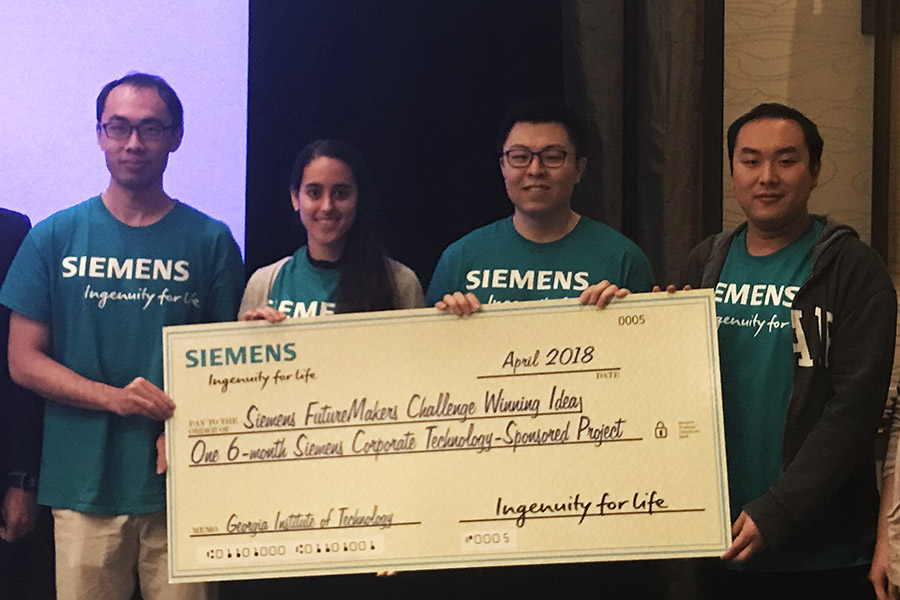 Four Georgia Tech graduate students have won a six-month sponsored project worth $140,000 from Siemens to turn a hackathon idea into a real-world tool for the company. From left to right, civil engineering students Yang Jiang, Emily Sanders and Heng Chi plus computation science and engineering student Yuyu Zhang combined machine learning and topology optimization to make computational design and digital manufacturing more efficient and effective as part of the Siemens FutureMakers Challenge at Georgia Tech May 5. (Photo Courtesy: Glaucio Paulino) |
Four Georgia Tech students will receive $140,000 from Siemens to turn a hackathon idea into reality after winning the company’s FutureMakers Challenge May 5.
The team — three civil engineering and one computational science and engineering graduate students — came up with a computational tool using advanced machine learning techniques and topology optimization to speed digital design and manufacturing. Rather than solving all the equations that would describe how a proposed design would work, their surrogate models quickly identify the design directions to pursue to create optimized results.
Any more details than that have to wait, as the students now firm up their idea and work with Siemens for the rest of the year to turn it into a real-world tool.
“We are very happy that Siemens is interested in the idea we proposed,” the group said in a statement. “Our research group is excited to work closely with Siemens to further mature the idea, to develop it into an efficient computational design tool, and to apply it to the exciting engineering problems that Siemens is working on.”
Siemens partnered with six universities for the hackathon, picking one project from each to fund and explore more fully. Teams worked for 24 hours to brainstorm, develop their idea, and code before presenting to judges. Three teams from Glaucio Paulino’s lab competed at Tech, finishing first and third.
“I’m very excited about this,” said Paulino, the Raymond Allen Jones Chair in the School of Civil and Environmental Engineering. “Civil engineering does not generally win this kind of competition. It’s often dominated by [students in] electrical engineering and computer science. For civil engineering to be on the map — I am happy. I am very proud.”
“Our whole research group has been striving to apply research outputs to solve practical problems, to promote interdisciplinary research collaboration, and to call attention from people outside to our expertise. The Siemens FutureMakers Challenge is a great platform to achieve those goals,” said Yang Jiang, a Ph.D. student and member of the winning team. “During the challenge, I felt so stimulated by the collision between the two mind sets of topology optimization and deep learning.”
Jiang’s collaborators included his labmates Heng Chi and Emily Sanders, plus Yuyu Zhang from the School of Computational Science and Engineering, who brought machine learning expertise to the group. The combination proved unexpectedly powerful, Sanders said.
“I didn’t know much about the challenge, and from the description, it didn’t seem like I had the relevant expertise to propose something meaningful for Siemens,” she said. “Professor Paulino must have seen our group’s potential to be competitive and strongly encouraged us to participate. Once I got there and started working in our cross-disciplinary team, I realized that our team had a great opportunity to propose an interesting and meaningful project.”
“The idea of working closely with Siemens, a world leading company for engineering technology and innovation, is very attractive to me,” said Chi, the team’s leader. “It will allow me to be better connected to the engineering practice and apply my knowledge to real-world problems.”
Judges weighed the hackathon ideas based on their creativity and how well they addressed real design problems. They also looked for a strong plan to execute the idea and rewarded teams that made a more complete demonstration of their concept.
Another team from the School led by Ph.D. student Shelly Zhang won third place for their software to help users optimize the shape of whatever product they might design as well as select the best type and amount of material for their designs.
The team also included Ke Liu, Larissa Novelino and Kyoungsoo Park.
“We all have different backgrounds — topology optimization, origami engineering, and fracture mechanics — but we share the same vision that imagination and innovation should not be constrained,” Zhang said. “That vision guided us through this 24-hour hackathon and helped us develop our approach.”

